Welcome to the Golden State of California, a place where the diverse landscapes provide an equally diverse array of Birds of Prey. From the haunting hoot of owls echoing through ancient Redwood forests, to the piercing cry of hawks soaring over arid desert dunes, each bird of prey adds its unique note to the state’s wild symphony. With majestic eagles, agile falcons, and the rare and awe-inspiring California Condor, California is a true haven for these captivating creatures.
List of Birds of Prey in California:
Red-tailed Hawk: As one of the most common raptors in North America, these hawks can be spotted across the state, soaring high over open fields and perching on high vantage points.
Turkey Vulture: These large, dark birds are often seen soaring in warm, rising air currents, searching for their next meal. They are widespread and can be seen throughout California.
American Kestrel: Known as the smallest falcon in North America, these colorful birds can be found in a wide variety of habitats across California.
Cooper’s Hawk: These agile raptors are found throughout California. They are often seen in woodlands, navigating deftly through trees as they hunt for smaller birds.
Western Screech-Owl: Native to western North America, these small owls can be found in wooded habitats across California, often heard after dusk with their distinctive calls.
Great Horned Owl: Widespread across North America, these adaptable owls are found throughout California, and are known for their distinctively deep hooting calls.
Bald Eagle: With numbers on the rise, these majestic raptors can be spotted near lakes and rivers, particularly in the northern parts of the state and the Channel Islands.
Northern Harrier: Known for their distinctive flight pattern, these raptors can be seen flying low over open fields and marshes across California.
Barn Owl: These nocturnal birds, known for their heart-shaped faces, are widespread across the state, often seen at dusk hunting for rodents.
Peregrine Falcon: While less common, these powerful falcons can be spotted along the coast and in large cities, where they nest on tall buildings.
Swainson’s Hawk: These long-distance migrants can be seen in agricultural areas and grasslands across California during spring and fall migrations.
Burrowing Owl: Unique for their ground-dwelling habits, these small owls inhabit grasslands and deserts in parts of California, often seen standing near their burrows during the day.
Golden Eagle: These large and majestic birds inhabit the mountainous regions and open areas of California, especially in the southern and central parts of the state.
Merlin: These small, powerful falcons are most commonly seen in California during migration and in winter, often found hunting along the coastline.
Northern Saw-whet Owl: These small owls prefer the coniferous forests of northern California and can be hard to spot due to their nocturnal habits.
Short-eared Owl: Mostly found in the grasslands and marshes of California, these owls are often active at dawn and dusk.
White-tailed Kite: Found in open grasslands and marshes across California, these small raptors are easily identified by their white underparts and black wingtips.
Ferruginous Hawk: This large hawk prefers the open spaces of California’s central valley and desert areas, often seen soaring high above the ground.
Zone-tailed Hawk: A rare sight in California, this hawk can be spotted in the southern regions of the state, often mistaken for a Turkey Vulture due to its similar flight pattern.
Red-shouldered Hawk: These colorful hawks are found throughout California, preferring wooded habitats near water.
California Condor: After a successful reintroduction effort, these critically endangered birds can be seen soaring over California’s mountain ranges, particularly in the Los Padres National Forest.
Long-eared Owl: These secretive owls inhabit the woodlands of California, often found roosting in dense foliage.
Spotted Owl: These endangered owls prefer the old-growth forests of northern California, where they hunt at night.
Rough-legged Hawk: A winter visitor to California, this hawk can be seen soaring over open country in search of small mammals.
Northern Goshawk: Preferring dense forests, this large and powerful hawk can be spotted in the mountainous regions of California.
Great Gray Owl: A rare resident of California, this large owl can be found in the dense forests of the state’s mountain regions.
Snowy Owl: These beautiful white owls are rare visitors to California, occasionally seen during irruptions, particularly in the northern parts of the state.
Common Black Hawk: A rare sight, this black hawk prefers riparian areas in the southernmost regions of California.
Crested Caracara: This striking raptor is an occasional visitor to California, often seen in open habitats.
Mississippi Kite: These elegant raptors are rarely seen in California, but can occasionally be found in the southeastern regions during migration.
Swallow-tailed Kite: Known for their deeply forked tail, these kites are very rare visitors to California.
Gray Hawk: These small raptors are rare visitors to the far southern edge of California, especially during spring migration.
Northern Pygmy-Owl: Found in coniferous forests and mixed woodland areas, these small owls can be seen in the mountainous regions of California.
Flammulated Owl: This small, elusive owl can be found in the coniferous forests of California, often heard during summer nights.
Elf Owl: The world’s smallest owl species, the Elf Owl is a rare visitor to the southern regions of California.
Osprey: Commonly found near lakes, rivers, and coastal waters, these fish-eating raptors can be seen throughout California, particularly during the breeding season.
Prairie Falcon: These large falcons prefer the open habitats of California’s central valley and desert areas, often seen soaring high above the ground.
Rarely spotted in California are the following birds of prey: Snowy Owl, Flammulated Owl, Great Gray Owl, Gyrfalcon, Eurasian Kestrel and Swallow-tailed Kite. These species are not commonly found in California and sightings of them are relatively uncommon.
This diverse array of birds of prey makes California a fantastic destination for raptor enthusiasts, from the arid desert landscapes to the towering Redwood forests. Each species contributes its own distinct call to the state’s wild chorus.
Red-tailed Hawk (Buteo jamaicensis)

The Red-tailed Hawk is a large bird of prey that is commonly found across North America. This species is part of the genus Buteo, which is often referred to as the “true hawks,” and includes more than two dozen species of raptors.
Red-tailed Hawks have a robust size, ranging from 18 to 26 inches in length and sporting a wingspan that can exceed 4 feet. They have a broad, rounded set of wings and a short, wide red tail. This species is most easily recognized by its rich, rust-colored tail, which gives it its common name. However, juvenile hawks might not yet have this distinctive feature.
Their feathers are generally dark brown on their dorsal side (back) with a lighter, often speckled, ventral side (front). The intensity and pattern of their plumage can vary significantly based on their age and geographic location, as there are about 14 recognized subspecies of Red-tailed Hawks.
As for their diet, Red-tailed Hawks are carnivores and have a broad diet that includes rodents, ground rabbits, reptiles, and other birds. They are skilled hunters that typically sit on high perches and use their keen eyesight to spot potential prey. Once they have identified a target, they swoop down to capture it with their powerful talons.
Red-tailed Hawks mate for life and build nests high off the ground, often in tall trees or on cliff edges. Their nests are made of sticks and can be quite large. They typically lay 1-3 eggs per year, which are incubated by both parents.
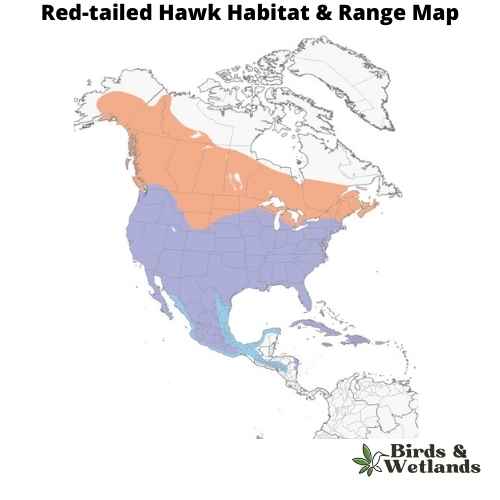
Red-tailed Hawk Sound
Turkey Vulture (Cathartes aura)

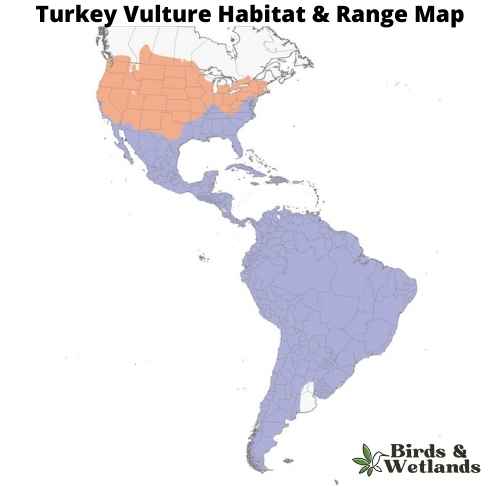
Turkey Vulture Sound
Scientific Name: Cathartes aura
Length: 24–32 in
Wingspan: 63–72 in
Weight: 1.8 to 5.3 lb
Turkey vultures are large birds that are easily recognizable by their bald heads, which are black in coloration, and by the patch of red skin below their beaks. It is white with black spots on the wings and tail. It has a bald head and a hooked beak that is black in coloration.
Turkey vultures live in the Americas, Europe, Africa, and Asia. They can be found in deserts, grasslands, forests and swamps. Turkey vultures are found throughout North America and parts of Central America and South America. In the U.S., they can be found across the country, but most commonly in the southwest region.
Turkey vultures eat carrion—dead animals’ remains such as dead deer, sheep, cows, horses and other large mammals that have been killed by other predators, such as coyotes or foxes. They do not hunt live prey.
Great Horned Owl (Bubo virginianus)

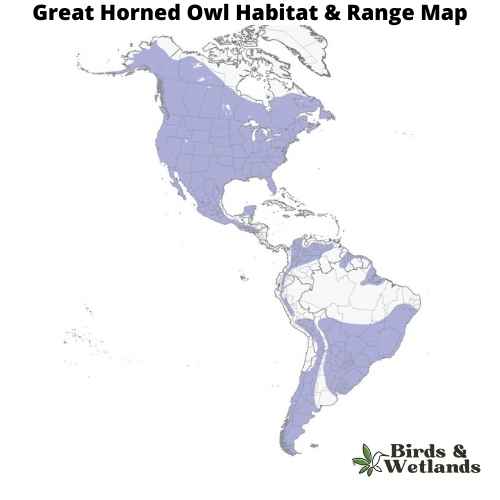
Great Horned Owl Sound
Scientific Name:Bubo virginianus
Length: 18.1-24.8 in
Wingspan: 39.8-57.1 in
Weight: 32.1-88.2 oz
The Great Horned Owl is a large owl with long wings and a large head. It’s one of the most common owls in North America.
Great Horned Owls are large, stocky birds with soft feathers that are gray to brown on their backs and white on their chests. Their faces are characterized by two black “ear” tufts, which can be raised or flattened depending on the owl’s mood. The eyes are yellow, orange, or red in color.
The habitat of the Great Horned Owl is a variety of different environments such as forests and deserts. They also live near water sources such as lakes, streams and rivers where they can hunt for fish.
The diet of the Great Horned Owl consists primarily of small mammals such as mice and rats; however they will also eat other rodents such as squirrels, rabbits and porcupines. They have been known to eat skunks too.
American Kestrel (Falco sparverius)
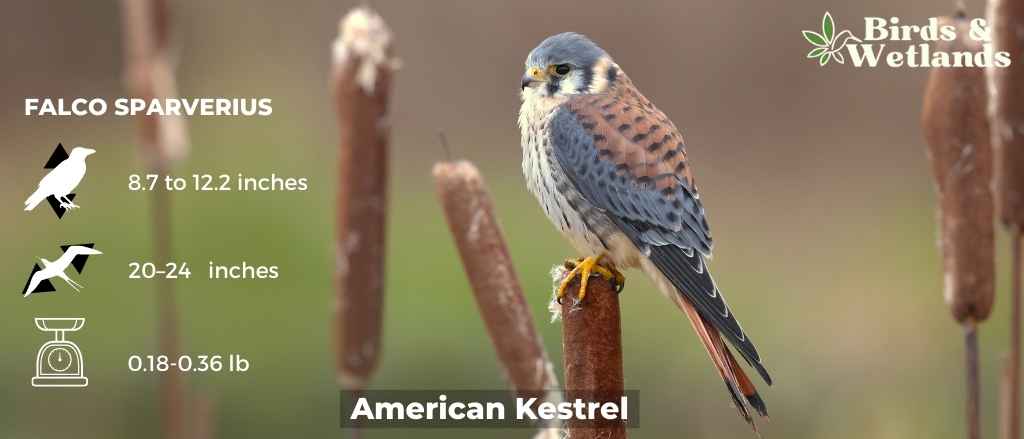
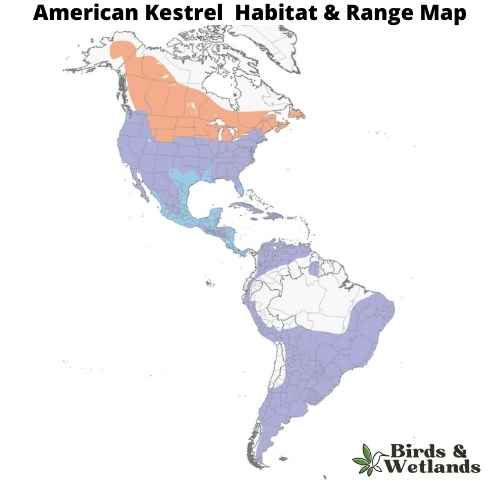
American Kestrel Sound
Scientific Name: Falco sparverius
Length: 8.7 to 12.2 in
Wingspan: 20–24 in
Weight: 3.0–5.8 oz
The American Kestrel, often recognized as the smallest and most brightly colored falcon in North America, exhibits a stunning array of rufous, blue and gray hues in its plumage. This bird, ranging in size from a mere 22 to 31 cm, carries distinct black facial markings that contrast with its white cheeks and has blue gray wings. Despite its small stature, the American Kestrel is a formidable predator, employing a unique hunting strategy that involves hovering at a height before swooping down on prey, primarily consisting of insects, small mammals, and occasionally small birds.
Residing predominantly in North and South America, the American Kestrel exhibits a preference for open habitats such as meadows, grasslands, and deserts. They are also found in both urban and suburban environments, nesting in cavities in trees, cliffs, buildings, and other structures. Kestrels are monogamous, with both sexes participating in the courtship displays that involve aerial acrobatics and feeding rituals. Nesting duties are a shared responsibility, with the male initially scouting for suitable locations and the female making the final selection. Both parents contribute to the incubation of the eggs and care of the young, ensuring the perpetuation of this captivating species.
Cooper’s Hawk (Accipiter cooperii)

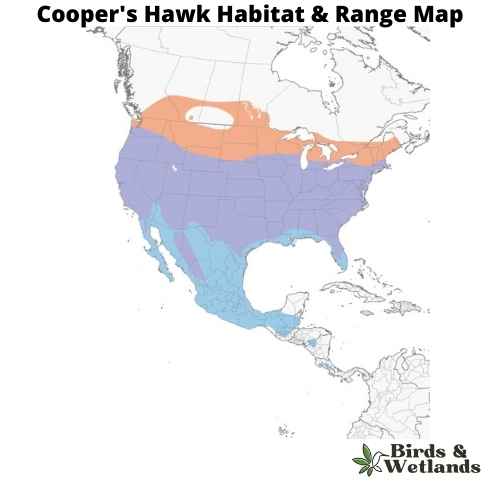
Listen:
The Cooper’s Hawk is a medium-sized bird of prey native to North America. Known for its agility and speed, it is part of the Accipitridae hawk species, which also includes other hawks, eagles, and kites.
Cooper’s Hawks are typically about 14 to 20 inches in length, with a wingspan ranging from 27 to 36 inches. They are known for their distinctive long, rounded tails and short, rounded wings. They have a steely blue gray top, with rusty bars on their underparts and thick, dark bands on their tails.
The Cooper’s Hawk is a skilled predator, primarily hunting birds and small mammals. They are adept at hunting in both dense forests and open areas, often catching prey mid-air in high-speed pursuits. They have also been known to visit the backyard bird feeder, not for the seed, but to prey on the smaller birds that gather there.
Cooper’s Hawks often build nests in dense tree canopies where they are well concealed. The female usually lays 3 to 5 eggs, and both parents share incubation duties. The young hawks fledge after about a month but will stay close to the nest, relying on their parents for food as they learn to hunt.
Bald Eagle (Haliaeetus leucocephalus)

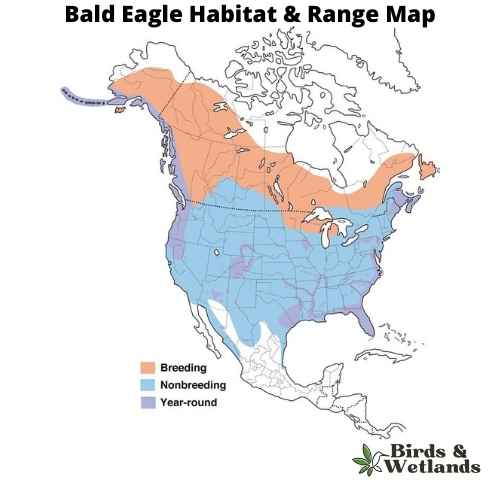
Bald Eagle Sound
Scientific Name: Haliaeetus leucocephalus
Length: 28–40 in
Wingspan: 5 ft 11 in and 7 ft 7 in
Weight: 6.6 -13.9 lb
The Bald Eagle, primarily found in Canada and Alaska, is instantly identifiable by its white head, dark brown body, yellow beak, and a piercing cry. Its sharp, orange-yellow eyes aid in efficient night hunting.
Predominantly residing in North America, occasionally venturing into Asia and Europe, it thrives near water bodies. It perches atop trees, providing a bird’s-eye view of its prey. It feeds on fish, carrion, small mammals like rabbits and squirrels, and reptiles. Hunting involves a swift downward swoop to seize the prey, carrying it back to the nest.
Bald Eagles are monogamous, forming lifelong pairings. They construct vast nests from sticks, lined with moss or grasses. They typically lay 1-3 eggs annually, which hatch around 35 days later. The fledglings leave the nest roughly 6 weeks after hatching, but continue to rely on their parents for nourishment for a further 5-6 months, until they become proficient hunters.
Western Screech-Owl (Western Screech-Owl)
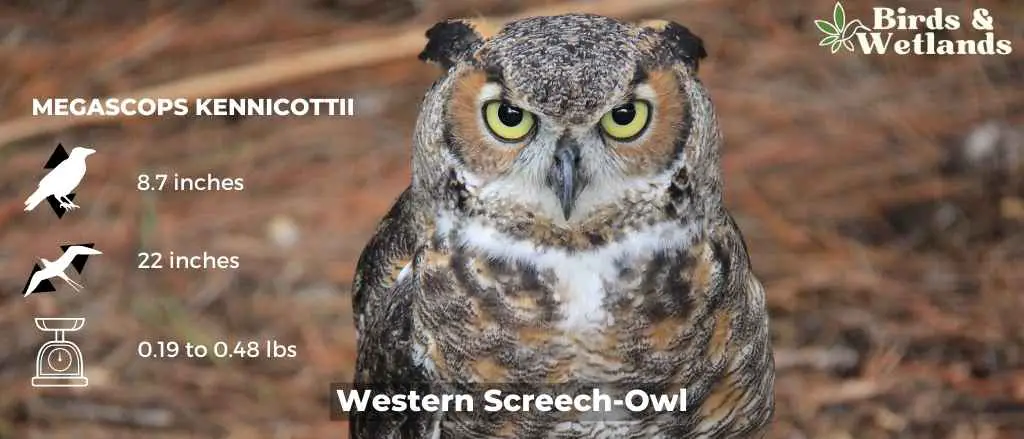
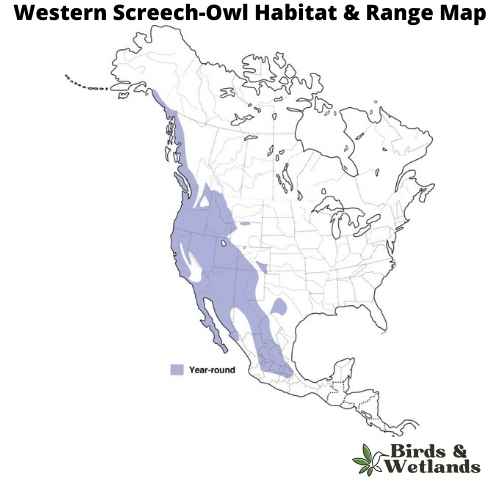
Western Screech-Owl Sound
Scientific Name: Megascops kennicottii
Length: 22 cm (8.7 in)
Wingspan: 55 cm (22 in)n
Weight: 88 to 220 g (3.1 to 7.8 oz)
The Western Screech-Owl, or Megascops kennicottii, is a small species of owl native to North and Central America. Western Screech-Owls are nocturnal predators, and its diet primarily consists of small mammals, birds, insects, and occasionally fish.
This owl is medium-sized compared to other screech-owls. It has a compact, stocky body, and is often recognized by its large head with yellow eyes surrounded by greyish-brown facial disks. The plumage is generally a mixture of grey and brown, with intricate patterns of spots and streaks that provide excellent camouflage against tree bark.
These owls prefer mixed woodland habitats, including deciduous forests and semi-open areas with trees. They often nest in tree cavities, but will also readily take to nest boxes if available. These birds are primarily non-migratory, and once they’ve established a territory, they tend to stay within the same area year-round.
Barn Owl (Tyto alba)

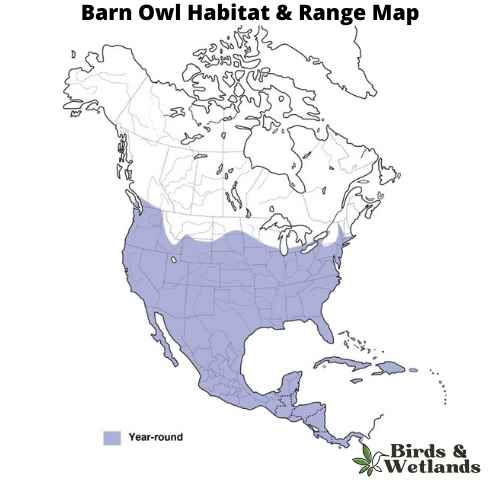
Barn Owl Sound
Scientific Name: Tyto alba
Length: 13 to 15 in
Wingspan: 31 to 37 in
Weight: 9.2 oz
The Barn Owl is a widespread species of owl known for its distinctive heart-shaped facial disc.
Barn Owls are medium-sized owls, they are pale overall with golden-brown wings and back, contrasted by a white face, chest, and belly. Their most notable feature is their heart-shaped facial disc, which helps channel sound to their ears.
Barn Owls are typically found in open habitats, including farmland, woodland, and marshes. They are named for their habit of nesting in human structures such as barns, church towers, and in the hollows of large trees. These owls are nocturnal, hunting at night and roosting during the day.
The diet of Barn Owls primarily consists of small mammals, particularly rodents such as mice and rats. They are known for their silent flight, which allows them to sneak up on their prey without detection.
Barn Owls have a unique nesting behavior. They do not build nests, but instead, lay their eggs directly on the bare surface of a secluded ledge or cavity. A female typically lays 4-7 eggs, and both parents help incubate the eggs and care for the chicks.
Northern Harrier (Circus hudsonius)

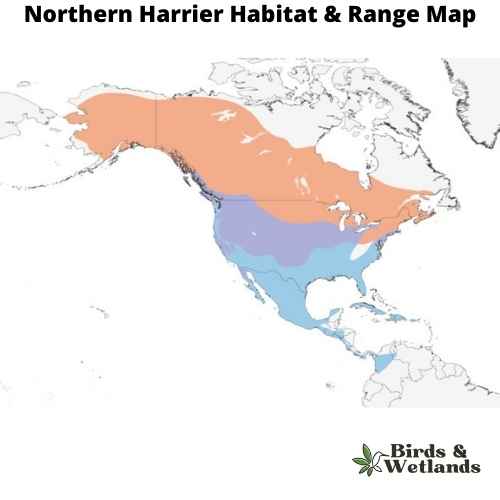
Listen:
The Northern Harrier is a medium-sized, slender hawk.
Adult birds are gray above, with pale bars on the wing feathers and white markings on the underwings and a white rump patch. The breast is barred with black and white, and the belly is streaked with brown.
They prefer open areas, such as grasslands and marshes, but can be found in almost any open habitat except dense woods.
Northern Harriers are opportunistic hunters that feed on small mammals such as mice, voles and rabbits as well as birds including quail, grouse and ducks. They hunt by flying low over open spaces such as fields or marshes.
Northern harrier nests on the ground in lowlands or hillsides near water bodies. It lays two to four eggs which hatch after 24 days of incubation by both parents. The chicks fledge after 30 days of hatching and remain dependent on their parents for another three weeks during which they learn how to fly.
Peregrine Falcon (Falco peregrinus)


Peregrine Falcon Sound
Scientific Name: Falco peregrinus
Length: 14.2-19.3 in
Wingspan: 39.4-43.3 in
Weight: 530-1600 g
Known for its blue-gray plumage and unique cheek bars, the Peregrine Falcon stands as a beacon of power and swiftness. Despite its modest size, it reigns as the world’s fastest creature, reaching staggering speeds up to 240 mph during hunting dives.
Its diet mainly includes birds, occasionally bats, caught in an enthralling aerial display of agility and precision. Adapting to diverse habitats, this bird graces every continent except Antarctica, finding home in environments from city skyscrapers to towering cliffs.
Peregrine Falcons, monogamous in nature, often pair for life, expressing their bonds through complex courtship flights filled with intricate aerial maneuvers. They construct simple scrape nests on high ledges, often without adding materials.
Their parenting duties are shared, from egg incubation to feeding and caring for the chicks, ensuring their offspring are ready to take on the skies in their own time.
Swainson’s Hawk (Buteo swainsoni)
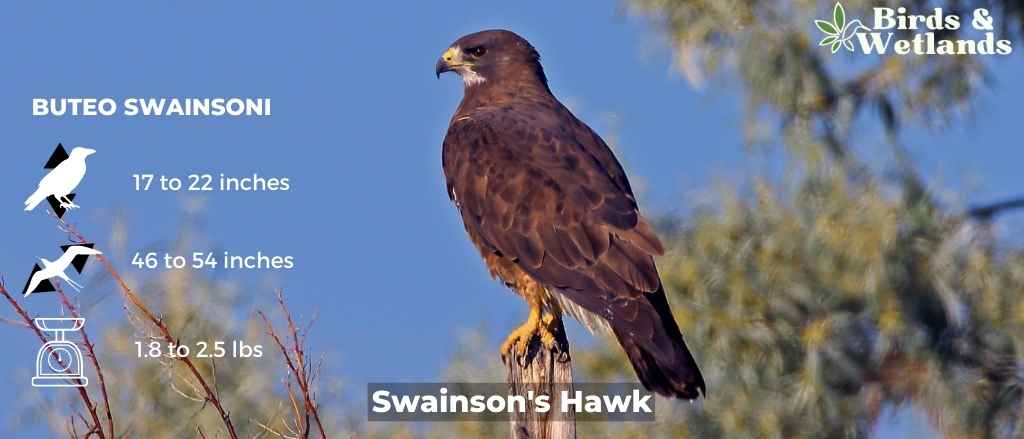
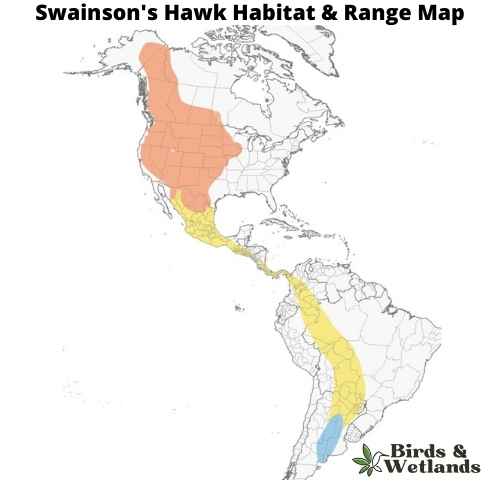
Listen: Swainson’s Hawk
Swainson’s Hawk is a medium-sized hawk that is found in North America and South America, Scientific Name: Buteo swainsoni.
The bird has a blue-gray plumage with a dark brown back, wings, and tail. It also has a white chest and belly. The beak and feet are black, but the eyes are yellow. They are often confused with Cooper’s Hawk because of similar coloring, but Swainson’s Hawks have wider tails and longer wings than their cousin species.
These birds eat small rodents such as gophers and mice. They also eat insects like grasshoppers and crickets during the summer months when they’re plentiful. They sometimes steal prey from other birds of prey such as Northern Harriers who hunt the same prey.
Swainson’s Hawks build nests on rocky cliffs near water sources where they can find food easily. They lay three to five eggs that hatch after about two months into fluffy brown baby hawks who leave the nest after about three weeks (or when they’re big enough).
Burrowing Owl (Athene cunicularia)

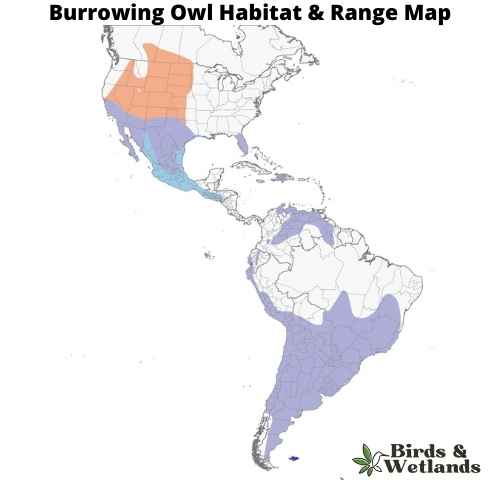
Burrowing Owl Sound
Scientific Name: Athene cunicularia
Length: 7–11 in
Wingspan: 20–24 in
Weight:5–8 oz
The Burrowing Owl is a small, long-legged species of owl found in North and South America. Known for its unusual habit of living in burrows in the ground.
Burrowing Owls have a rounded head with no ear tufts and bright yellow eyes. Their overall coloration is mottled brown and white with a distinct white “eyebrow” above each eye.
Their primary habitat includes open landscapes such as grasslands, deserts, agricultural areas, golf courses, and even airports. As their name suggests, these owls often reside in burrows, many of which are abandoned by prairie dogs, ground squirrels, or other burrowing animals. In some cases, they may also dig their own burrows.
Burrowing Owls diet consists mainly of small mammals and insects, but they also eat birds and reptiles.
Burrowing Owls have a unique nesting behavior. They lay their eggs in an underground burrow to protect them from predators and extreme weather. Clutch sizes range from 6 to 11 eggs, which are incubated for about a month before hatching.
Golden Eagle (Aquila chrysaetos)


Golden Eagle Sound
Scientific Name:Aquila chrysaetos
Length: 26 to 40 in
Wingspan: 5 ft 11 in to 7 ft 8 in
Weight: 8.9 and 14.0 lb
The Golden Eagle is a large bird of prey known for its strength, speed, and hunting prowess.
Adult Golden Eagles are large birds, and are named for the golden-brown plumage on their heads and necks, which contrasts with their darker brown body feathers. Their eyes, legs, and bill are all yellow.
These eagles prefer open, rugged terrain, including mountains, hills, grasslands, and deserts. They are most often found in areas that provide good opportunities for soaring and hunting.
Golden Eagles have a varied diet but primarily prey on small to medium-sized mammals such as rabbits, hares, and ground squirrels. They are also capable of taking larger prey, like young deer or livestock, but these are not typically part of their diet.
Golden Eagles build large nests or eyries, usually on cliffs or in tall trees. The nests are often reused and added to each year, becoming enormous structures over time. The female typically lays 1 to 4 eggs, which both parents incubate.
Merlin (Falco columbarius)

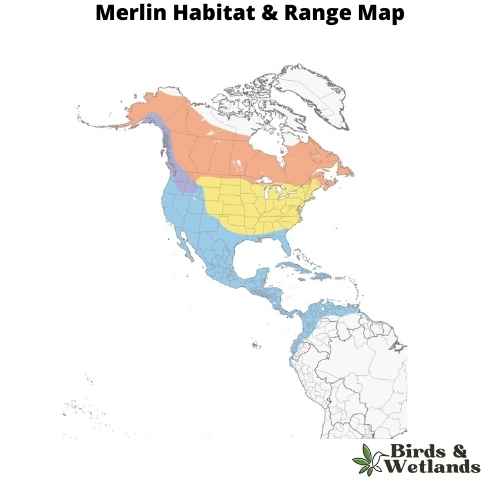
Merlin Sound
Scientific Name: Falco columbarius
Length: 9.4–13.0 in
Wingspan: 20–29 in
Weight: 5.8 – 8.1 ozz
The Merlin is a small, robust falcon known for its blue-gray or dark brown upperparts and thinly streaked, buff to orange underparts. Unlike other falcons, it has faint facial markings, offering a more uniform look.
This compact bird, renowned for its hunting prowess, chases down small birds in mid-air, exemplifying its impressive speed and agility.
Residing across northern North America, Europe, and Asia, the Merlin prefers open or semi-open landscapes. Rather than constructing their own nests, they tend to reuse old crow or raptor nests, or choose to nest on the ground in open habitats.
During courtship, males perform elaborate aerial displays. Both parents share egg incubation duties, with the male also responsible for feeding the family, reflecting the Merlin’s fascinating role in the biodiversity of its ecosystems.
Northern Saw-whet Owl (Aegolius acadicus)

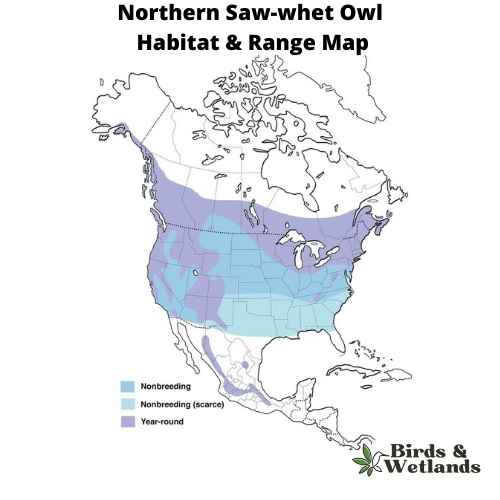
Northern Saw-whet Owl Sound
Scientific Name: Aegolius acadicus
Length: 17–22 cm (6.7–8.7 in)
Wingspan: 42–56.3 cm (16.5–22.2 in)
Weight: 54 to 151 g (1.9 to 5.3 oz)
The Northern Saw-whet Owl is a tiny, speckled gray owl and it’s one of the smallest owls in North America. It’s also known as the Little Owl or Wood Owl in some areas.
Northern Saw-whet Owls have dark brown eyes, white eyebrows, and yellow beak. It has brownish-grey feathers that are spotted with white. The owl’s legs are covered in feathers and appear nearly invisible when the bird is perched on a branch or tree.
In the winter they migrate south to warmer climates. They prefer to live in dense coniferous forest with large trees but will occasionally nest in shrubs or other vegetation that can protect them from predators.
The Northern Saw-whet Owl eats mice and voles (small rodents), small birds, frogs, salamanders, moles and shrews, but unlike most owls they chop their prey up and spread over a few meals. They will also eat insects like beetles and grasshoppers if they are available. It hunts from a perch at night using its excellent hearing to locate prey items within about 30 feet (9 meters) of its nest.
These owls nest in tree cavities usually located close to water sources such as lakes or rivers where they can find their food source (insects). They lay 2-4 eggs at one time which incubate for about 30 days before hatching.
Short-eared Owl (Asio flammeus)


Short-eared Owl Sound
Scientific Name: Asio flammeus
Length: 13–17 in
Wingspan: 33 to 43 in
Weight: 7.3–16.8 oz
The Short-eared Owl is a medium-sized owl species with a wide distribution, found across North and South America, Europe, Asia, and many Pacific islands. Despite its name, the “ears” of the Short-eared Owl are not often visible, as they are small and tend to blend with the bird’s feathers.
The owls are predominantly brown with buff and white accents throughout their body and wings, and dark patches around their yellow eyes.
Short-eared Owls diet consists largely of small mammals, especially voles. However, they are opportunistic hunters and will also prey on a variety of other animals, including other birds, when available.
Their habitat is characterized by open areas like grasslands, marshes, and tundra. They nest on the ground, which is unusual for owls, and this makes them vulnerable to ground predators. As such, they often live in areas with tall grasses or other ground cover for protection.
White-tailed Kite (Elanus leucurus)
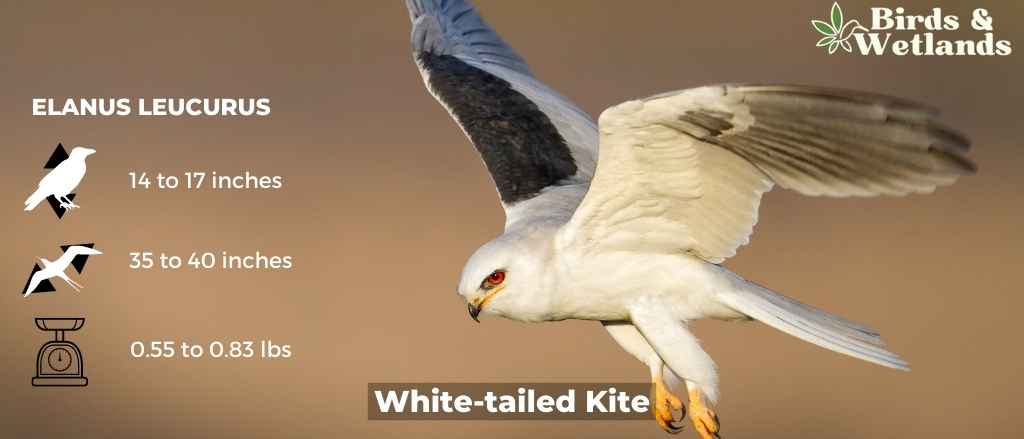
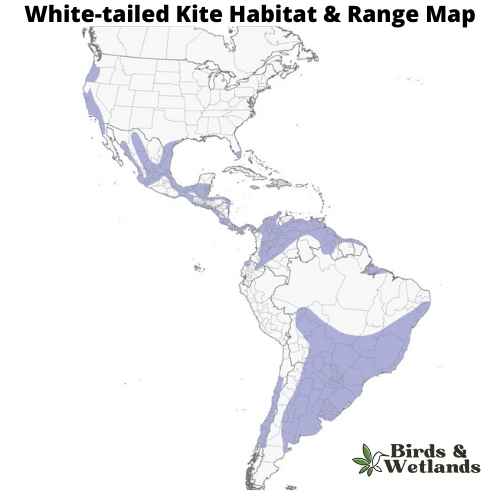
White-tailed Kite Sound
Scientific Name: Elanus leucurus
Length: 14–17 in
Wingspan: 35–40 in
Weight: (8.8–13.4 oz
The White-tailed Kite is a medium-sized bird of prey that is found throughout the Americas, from the western United States down through Central America and into South America.
White-tailed Kites have a striking appearance, with a white body, grey wings, and black shoulders. Their wings are long and pointed, giving them an elegant, buoyant flight. They get their name from their long, white tail.
They are primarily found in open grasslands, marshes, and savannas, often near bodies of water. They are known for their distinctive hunting technique, where they hover in the air before dropping onto their prey.
Their diet mainly consists of small rodents, especially voles and mice, which they hunt during the day. They are especially skilled at hunting in grassy habitats, where they can spot the movement of their prey from a distance.
White-tailed Kites are monogamous birds, with pairs building nests together in the tops of trees. They usually lay 3-5 eggs, which are incubated by both parents. After hatching, both parents take turns feeding the young.
Ferruginous Hawk (Buteo regalis)

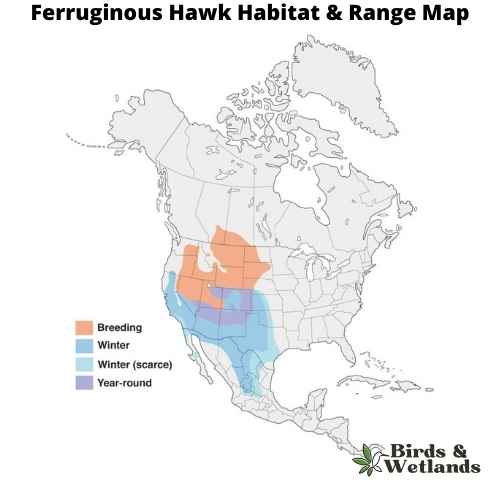
Ferruginous Hawk Sound
Scientific Name: Buteo regalis
Length: 20 to 27 in
Wingspan: 48 to 60 in
Weight: 32.0 to 80.0 oz
The Ferruginous Hawkis the largest hawk species native to North America. Known for its distinctive coloration and impressive size, this bird of prey predominantly inhabits the open landscapes of the western United States and parts of Canada.
Ferruginous Hawks are notable for their “ferruginous” or rust-colored back and shoulders, which contrasts sharply with the bird’s white underside. The hawk also has broad, rounded wings and a large, gape-mouthed beak. Ferruginous hawks exhibit dark morph and light morphs. Dark morphs have dark brown plumage, while light morphs display lighter, reddish-brown plumage. Morphs vary geographically.
Primarily feeding on small to medium sized mammals like rabbits and prairie dogs, the Ferruginous Hawk is an agile hunter, often seen soaring high above the ground or perched prominently while scanning for prey. It occasionally feeds on birds, reptiles, and insects as well.
Nesting for Ferruginous Hawks typically occurs on cliffs, hillsides, or large trees. The female lays between 2 to 5 eggs, and both parents share in the incubation and rearing of the chicks. The Ferruginous Hawk is a relatively solitary bird outside of the breeding season, and its call is a loud, high-pitched scream, often heard during courtship or near the nest.
Sharp-shinned Hawk (Accipiter striatus)

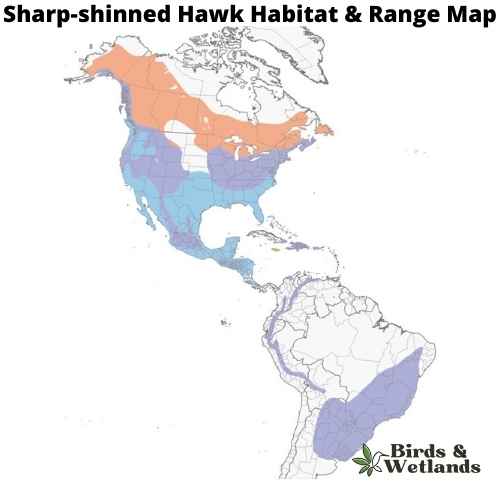
Listen:
The adult bird is brown on top and white underneath, with a dark brown band across its chest. It has short, rounded wings and a long tail that makes it look larger than it actually is. Adult sharp shinned hawks have black eyes, which are surrounded by white feathers. The female Sharp-shinned Hawk is browner than the male, who has darker brown markings on his back.
Sharp-shinned Hawks prefer open country for their habitat, including fields and meadows where they can hunt for mice and other small animals. They can be found throughout the United States but are most common in the east.
Sharp-shinned Hawks eat mostly small birds, such as sparrows and warblers, as well as small mammals such as mice and gophers. They catch prey by surprise using their incredible speed and agility, diving out of the sky at speeds up to 200 mph.
Sharp-shinned Hawks have an unusual hunting style for hawks—they prefer to catch their prey from perches above trees or telephone wires, rather than swooping down from above like most other hawks do and can often be seen hunting near bird feeders.
Zone-tailed Hawk (Buteo albonotatus)
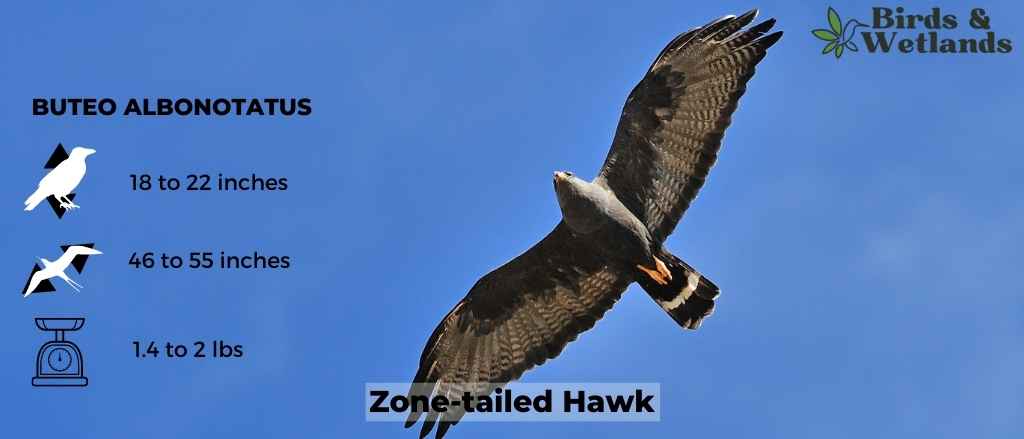

Zone-tailed Hawk Sound
Scientific Name: Buteo albonotatus
Length: 18 to 22 in
Wingspan: 46 to 55 in
Weight: 1.2 to 2 lb
The Zone-tailed Hawk, or Buteo albonotatus, is a medium-sized bird of prey known for its unique appearance and behavior that mimics turkey vultures, a strategy used to deceive prey. This raptor is primarily found in the warmer regions of the Americas, including the southwestern United States, Mexico, and down to Argentina.
The Zone-tailed Hawks body are predominantly black, with white bands, or “zones,” on the tail, which give the bird its name. From a distance, the Zone-tailed Hawk can easily be mistaken for a turkey vulture due to its similar coloration and flight pattern.
Zone-tailed Hawk feeds on small mammals, birds, and reptiles. Its hunting strategy is particularly clever. By mimicking the less-threatening turkey vulture in flight, it can often approach prey unnoticed before launching a surprise attack.
Nesting typically takes place in trees, cliffs, or even on man-made structures. The female lays 1 to 3 eggs, and both parents share incubation and feeding duties.
Red-shouldered Hawk (Buteo lineatus)

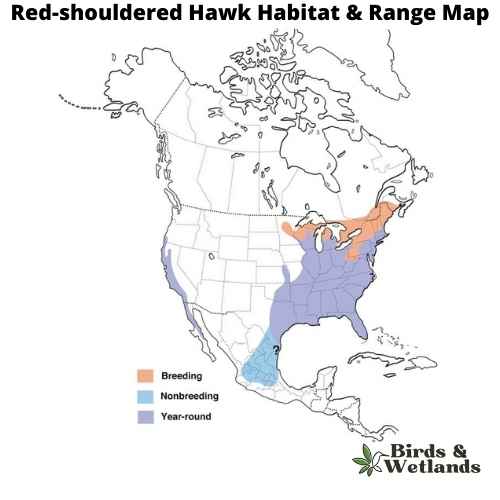
Listen:
The red-shouldered hawk are medium sized birds of prey, part of the buteo hawks family. It can be distinguished from other hawks by its reddish iris and pale legs.
The adult has rusty red upperparts, white underparts, a black chin and throat, and a reddish brown stripe over each eye, reddish brown heads and a strongly banded tail. The tail is reddish brown with two paler bands across it and they have white checkered wings. Juveniles are brown with dark barring and have pale fringes on the feathers of their wings.
Red-shouldered hawks nest in trees, though they also inhabit manmade structures including barns, bridges, and buildings. They prefer wooded areas with an open canopy but will use other places as well for nesting such as shrubs and hedges if needed.
The red-shouldered hawk’s diet – they eat small mammals such as ground squirrels, rabbits, voles, mice and rats. They also eat birds such as quail, pigeons and doves; reptiles including snakes; amphibians; fish; crustaceans; insects; and carrion (dead animals).
California Condor (Gymnogyps californianus)
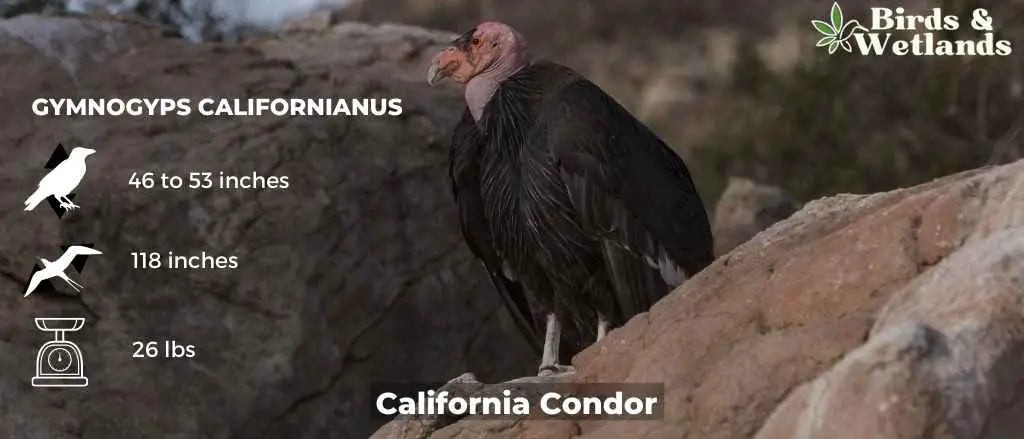

Scientific Name: Gymnogyps californianus
Length: 46-53 in
Wingspan: 9.8 ft
Weight: 26 lb
The California condor is one of the largest land birds in North America.
California condors are large black vultures with white heads, necks, and underbellies. Their feathers have dark tips and shafts, giving them a mottled look when viewed from a distance. They have a bald red head with a black eye patch and a white base of their bill which gives them an “old man” look.
They live in temperate forests along mountain ranges where there are large trees for roosting at night. They can also be found near water sources like rivers or lakes because they need water to drink as well as bathe themselves regularly.
They are scavengers that feed on dead animals such as carrion (dead bodies), carcasses, and garbage. They also eat live animals such as rabbits and small rodents but this is rare because they only need to eat once every couple of days at most.
They prefer open land with cliffs or rocky areas for nesting. The birds feed on carrion—dead animals that have already been killed by other predators or humans—and sometimes small animals such as mice and rabbits if necessary. California Condors build large nests out of sticks high up on cliffsides or sometimes in trees. They lay one egg every other year and incubate it for two months before hatching happens. The young condors will spend five months learning how to fly before they leave their parents’ territory around eight months old (older ones might stay longer).
The long-eared owl (Asio otus)

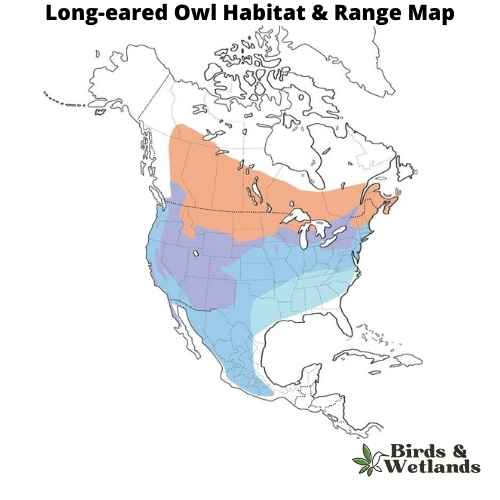
Long-eared Owl Sound
Scientific Name: Asio otus
Length: 12 and 16 in
Wingspan: 2 ft 10 in to 3 ft 4 in
Weight: 5.6 to 15.3 oz
The Long-eared Owl is a medium-sized owl species known for its distinctively long ear tufts, which can be raised or lowered depending on the bird’s mood or intention.
Long-eared Owls have mottled brown and cream plumage, which provides excellent camouflage among the trees. Their most distinctive features are their long, black-tipped ear tufts, which are set closer to the center of the head than in most other owl species.
These owls inhabit a wide variety of habitats, including deciduous and coniferous forests, woodlands, and even semi-deserts.
The Long-eared Owl’s diet primarily consists of small mammals, especially voles, but they will also take small birds and insects. They are skillful hunters, often capturing prey from a perch or in flight.
In terms of nesting behavior, Long-eared Owls do not construct their own nests, instead they take over old nests built by other bird species, usually those of corvids or other large birds. They lay an average of 4 to 5 eggs, which are incubated by the female while the male provides food.
The Spotted Owl (Strix occidentalis)
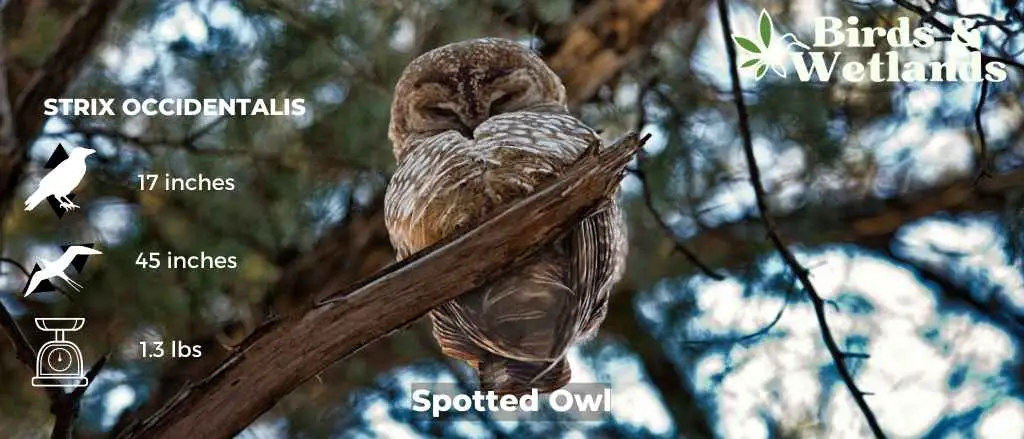
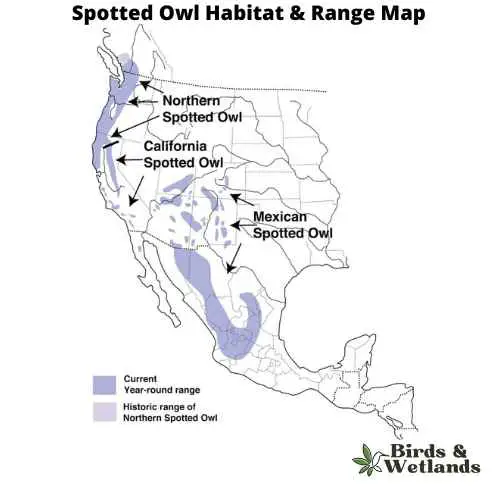
Scientific Name: Strix occidentalis
Length: 17in
Wingspan: 45 in
Weight: 1.3 lb
Spotted owls have a large head and eyes, with a small beak. Their feathers are light brown in color, with white spots on their wing feathers, and dark bars on their tail feathers. They have white spots on their upper body and wings. It has large yellow eyes and a yellow beak.
Its habitat is usually dense coniferous forests. It can be found in old-growth forests of the Pacific Northwest, where it often nests in trees at least 40 feet high.
The spotted owl feeds on small mammals such as rodents and squirrels as well as birds like quail and grouse. It hunts at night when most other animals are sleeping so that it doesn’t get caught by predators like hawks or snakes which also hunt at night time.
Spotted Owls usually nest in tree cavities created by woodpeckers or other birds who eat holes in trees where they make their nests too! The female lays three eggs at a time and both parents take turns sitting on them while they’re incubating (hatching). Once they hatch out, the parents take turns feeding them until they are old enough to hunt for themselves.
Rough-legged Hawk (Buteo lagopus)

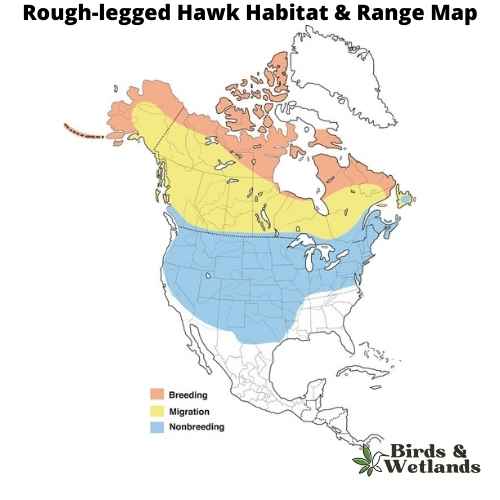
Rough-legged Hawk Sound
The Rough-legged Hawk is a large, raptor that is native to North America. It is also known as the American Rough-legged Hawk. Scientific Name: Buteo lagopus
The Rough-legged Hawk is a medium-sized hawk with a distinctive appearance, with dark brown feathers on its back and light brown feathers on its underside and broad thin wings. The hawk’s legs are also covered in dark feathers, which help to distinguish it from other species of hawk. The tail is barred with black and white. They have yellow eyes and dark feet.
Rough-legged Hawks hunt from above ground level, swooping down to catch its prey in its talons. When hunting for food, they prefer to eat small mammals such as squirrels and rabbits but will also eat birds if there aren’t any small mammals available. Although they eat a variety of small animals including birds, rodents, bats and reptiles, they rely heavily on fish for food during breeding season because it provides them with protein and calcium needed to produce eggs.
Northern Goshawk (Accipiter gentilis)


Listen:
The Northern Goshawk is a medium-sized hawk that is found in North America, Europe and Asia. It has brown eyes, a large sharp beak, and dark brown plumage on its upperparts and head, with white underparts that are spotted with brown barring. Its tail feathers are grayish-black with a dark band near the tip.
Northern goshawks eat squirrels, rabbits, grouse, woodchucks and other small mammals like voles or mice (which they often eat whole). They will also take larger prey such as deer fawns or even adult deer if they have no other choice. They have broad wings with long feathers that allow them to glide through the air when they catch their prey. They also have an excellent sense of smell which helps them locate their food source.
The Northern Goshawk builds its nest in a tree cavity or on a ledge, usually on the edge of an open area so it can easily see prey below. The female lays 3 to 5 eggs over two days and incubates them for 28 to 30 days while the male brings food to her every few hours until they hatch. The young fledge after about 6 weeks and leave the nest when they are about 10 weeks old.
Great Gray Owl (Strix nebulosa)
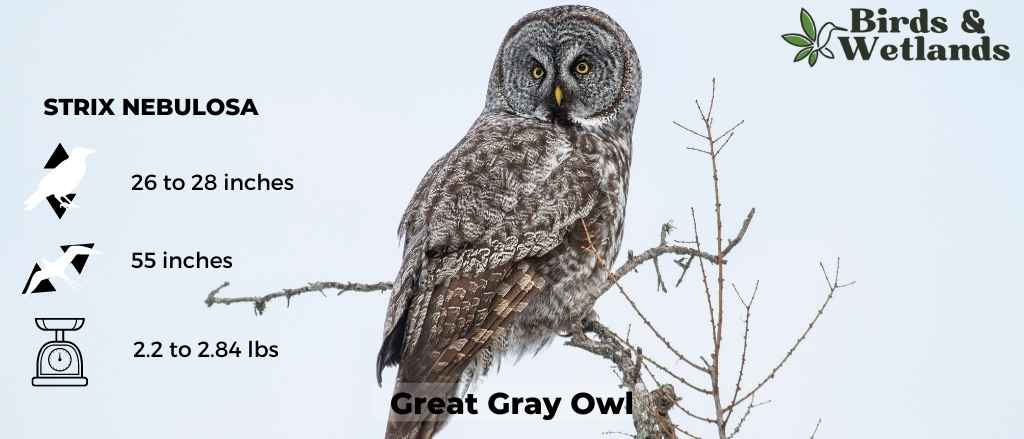
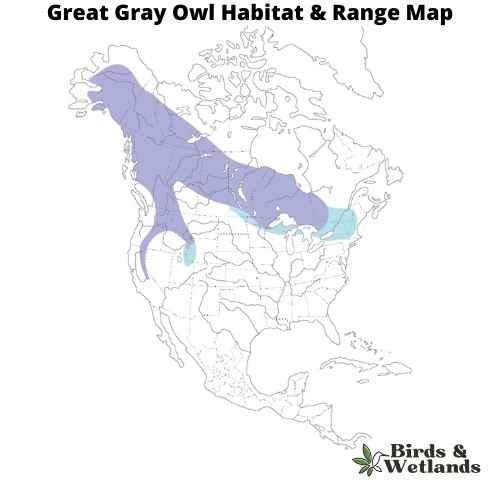
Great Gray Owl Sound
Scientific Name: Strix nebulosa
Length: 26 in to 28 in
Wingspan: 56 to 60 in
Weight:2.2 lb to 2.85lb
The Great Gray Owl, or Strix nebulosa, is a very large owl, native to the boreal forests across North America and Eurasia. Despite its great size, it’s more so known for its impressive appearance rather than its weight, as it is outweighed by several other large owl species.
The Great Gray Owl has a large, rounded head with a grey face and yellow eyes, surrounded by concentric circles of dark and light feathering. It is known for its bow-tie-shaped white moustache stripe and black chin spot.
One of the distinguishing characteristics of this owl is its elongated tail, which makes it appear much larger than it actually is. The plumage is mostly grey with a unique pattern of fine white, gray, and brown streaks and bars. Despite its large size, its diet primarily consists of small rodents, like voles and pocket gophers.
Great Gray Owls prefer dense coniferous forests, often near open meadows or bogs. Rather than building their own nests, they typically use nests previously built by other large birds, such as hawks or crows. They also occasionally nest in broken-top trees or on man-made structures.
Snowy owl (Bubo scandiacus)
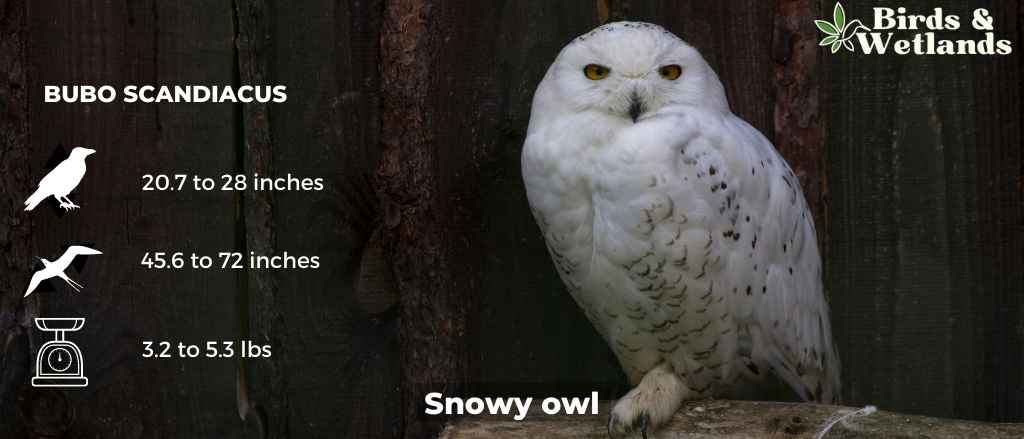
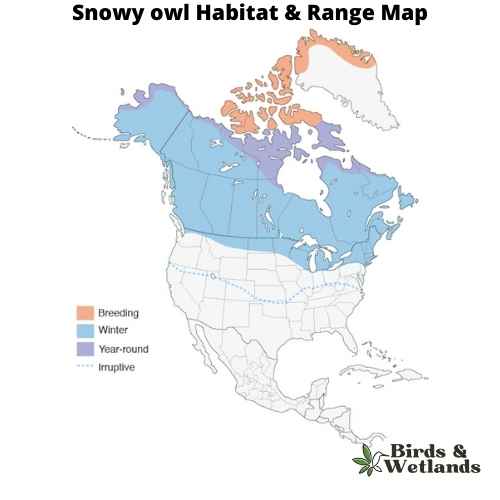
Snowy owl Sound
Scientific Name: Bubo scandiacus
Length: 20.7 to 28 in
Wingspan: 3 ft 10 in to 6 ft 0 in
Weight: 3.2lb to 5.3lb
The Snowy Owl, is of the most well-known species of owls, the Snowy Owl is renowned for its striking appearance and adaptations to its extreme environment.
Snowy Owls are medium sized birds that possess a rounded head, yellow eyes, and a black beak. The most distinctive feature of the Snowy Owl is its white plumage, which provides effective camouflage in its snowy habitat. Male Snowy Owls are often almost completely white, while females and younger owls have more extensive dark barring on their plumage.
Unlike many owl species, Snowy Owls are primarily diurnal, which means they are active during the day. This is an adaptation to life in the Arctic, where there can be 24 hours of daylight in the summer. Their diet mainly consists of small mammals, particularly lemmings, but they are known to eat a variety of animals including birds, fish, and even carrion when necessary.
Snowy Owls nest on the ground, usually on a mound or boulder. Their breeding success is closely tied to the availability of food, and in good years a single pair of owls can raise a large brood of chicks.
Common Black Hawk (Buteogallus anthracinus)
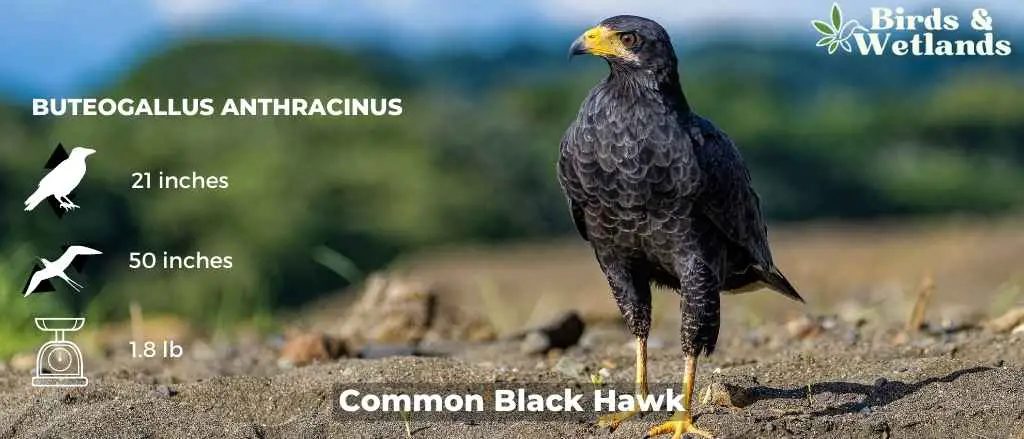
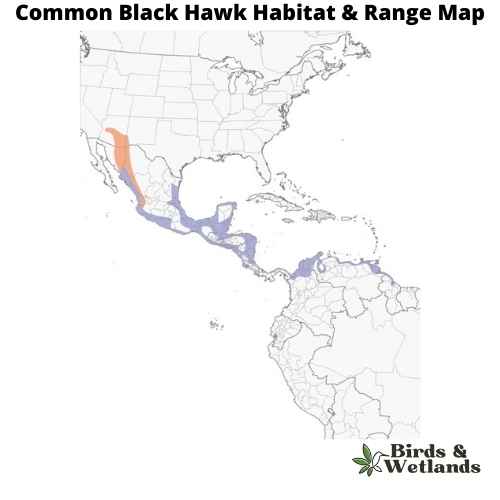
Common Black Hawk Sound
Scientific Name: Buteogallus anthracinus
Length: 21 in
Wingspan: 50 in
Weight: 840g
The black hawk has dark brown feathers on its back and chest, with white feathers on its belly and under its tail. The back feathers have white spots and bars that give it an overall speckled appearance. Its eyes are yellowish-brown, and its legs are long and pinkish-white in color with black talons at the end.
Common Black Hawks tend to live in open spaces near water sources like lakes or rivers because they need water for bathing and drinking as well as hunting prey animals that may be found near such areas.
Common Black Hawks prefer to hunt for small mammals like rabbits, squirrels, and rats. They also eat reptiles like snakes and lizards if they can find them.
Crested Caracara (Caracara plancus)
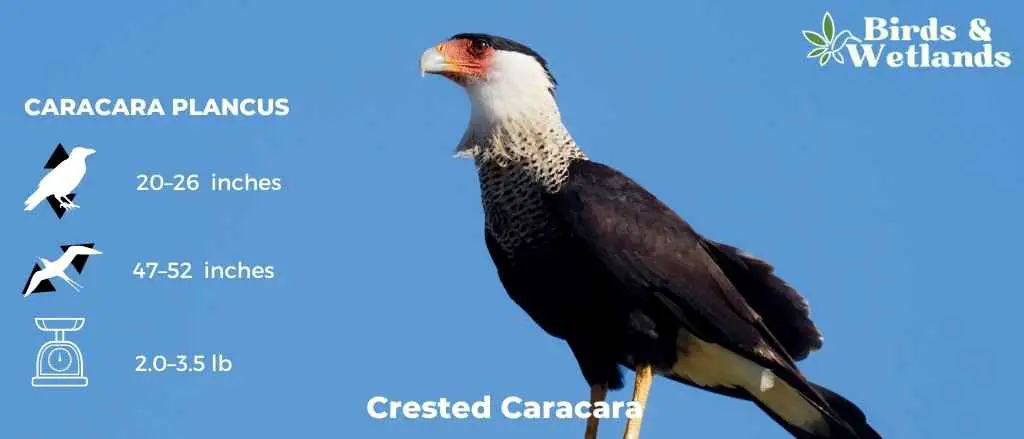
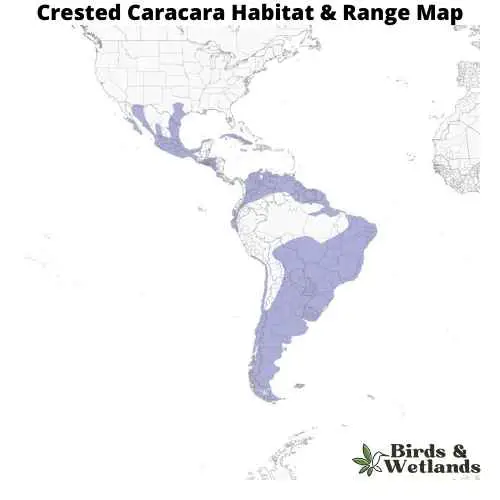
Crested Caracara Sound
Scientific Name: Caracara plancus
Length: 20-26 in
Wingspan: 47 – 52 in
Weight: 2-3.5lbs
The Crested Caracara is a medium-sized bird with a long, heavy body. They are mostly brown in color and have a dark brown or blackish crown, nape, and upper back. The wings and tail are grayish brown and the underparts are white. The bill is pinkish gray and the legs are gray.
Caracaras feed on small animals including reptiles, amphibians and insects that they find on the floor of forest areas where they live. They will also eat fruit if it is available but this is not their preferred food but for survival during times when other sources are scarce. They’re very good at finding food because they have very good eyesight and hearing abilities.
The Crested Caracara is known for its unique behavior when it comes to raising young. Rather than building nests themselves, they will steal from other birds—like hummingbirds or smaller raptors—and then make their own nest out of stolen materials. They also have strong claws that allow them to tear apart eggshells with ease so they can get at the eggs inside them.
Mississippi Kite (Ictinia mississippiensis)

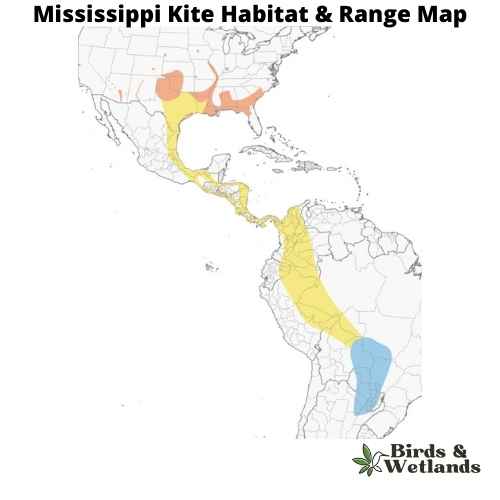
Mississippi Kite Sound
Scientific Name: Ictinia mississippiensis
Length: 12 to 15 inches (30–37 cm)
Wingspan: 3 feet (91 cm)
Weight: 214 to 388 grams (7.6–13.7 oz)
The Mississippi kite is a medium-sized bird of prey native to North America. It has a white belly and chest, with brown wings and tail and pointed wings. They have a black mask on their face, and the males have blue markings on their wings.
The Mississippi kites habitat is open grassland, including prairies, pastures, and meadows. It can also be found in wetlands such as marshes and swamps. It prefers warmer climates but can survive in cooler regions if there are many trees nearby that provide nesting sites.
The diet of these birds consists mostly of insects such as grasshoppers, beetles and dragonflies. They also eat small rodents that they catch while flying over fields or while perched on tall trees or telephone poles.
The Mississippis kite nest looks like a shallow bowl built with sticks, twigs and grasses. They lay between 2-5 eggs per year, which take about two weeks to hatch into chicks that fledge after two months. The breeding season for Mississippi Kites typically occurs from May to July
Swallow-tailed Kite
Gray Hawk (Buteo plagiatus)

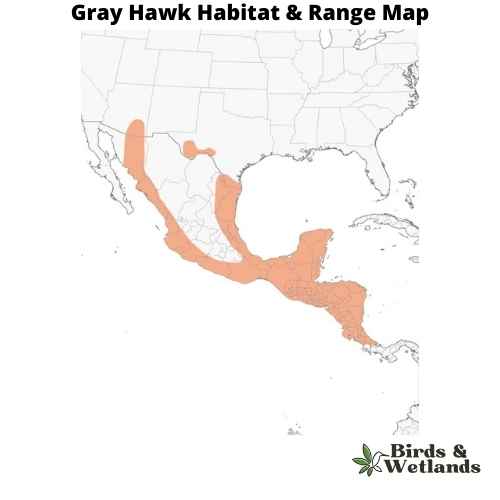
Gray Hawk Sound
Scientific Name: Buteo plagiatus
Length: 18–24 in
Wingspan: 82-98 cm
Weight: 16.8 oz
The Gray Hawk is a small bird of prey native to the Americas. Known for its distinct coloration and elegant flight, this raptor is found in both the southwestern United States and across Central and South America.
Gray Hawks plumage is characterized by a light gray body, contrasted with a darker gray back and wings. Its tail features broad white and gray bands, making it a distinctive feature.
Primarily hunting from a perch, the Gray Hawk feeds mainly on small mammals, birds, and reptiles, including lizards and snakes. It often patrols the edges of clearings, diving swiftly to catch prey off guard.
Nesting for the Gray Hawk typically occurs in trees. The female usually lays 1 to 3 eggs, and both parents share in incubation duties. The nestlings are generally dependent on the parents for food for a few weeks after hatching.
The Gray Hawk’s call is a high-pitched, plaintive scream, which is often repeated several times. The species is primarily a solitary bird, usually seen alone or in pairs.
Northern Pygmy-Owl (Glaucidium gnoma)

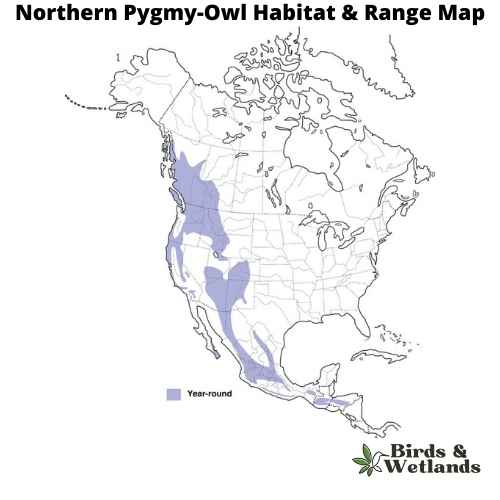
Northern Pygmy-Owl Sound
Scientific Name: Glaucidium gnoma
Length: 7 – 7 1/2 in)
Wingspan: 14.5 – 16 in
Weight: 62-73g
The Northern Pygmy-Owl is a small owl species native to North and Central America. Despite its small size, this owl is a fierce predator, known for its distinctive call and daytime hunting habits.
They have a rounded head without ear tufts and large yellow eyes. Their overall coloration is gray or brown with a pattern of white spots on the back and streaks on the front.
Northern Pygmy-Owls inhabit a range of habitats, including coniferous forests, deciduous woodlands, and mixed forests. They can be found at a range of elevations from lowlands to mountains. Unlike many other owl species, they are often active during the day, particularly in the early morning and late afternoon.
Their diet primarily consists of small mammals and birds, but they are also known to eat insects and reptiles. Despite their small size, they have been known to take prey up to three times their own size.
Northern Pygmy-Owls nest in tree cavities, often those created by woodpeckers. They do not build nests of their own but will add a few feathers to the cavity. Clutch size is usually around 2 to 7 eggs, which are incubated by the female while the male brings food.
Flammulated Owl (Psiloscops flammeolus)
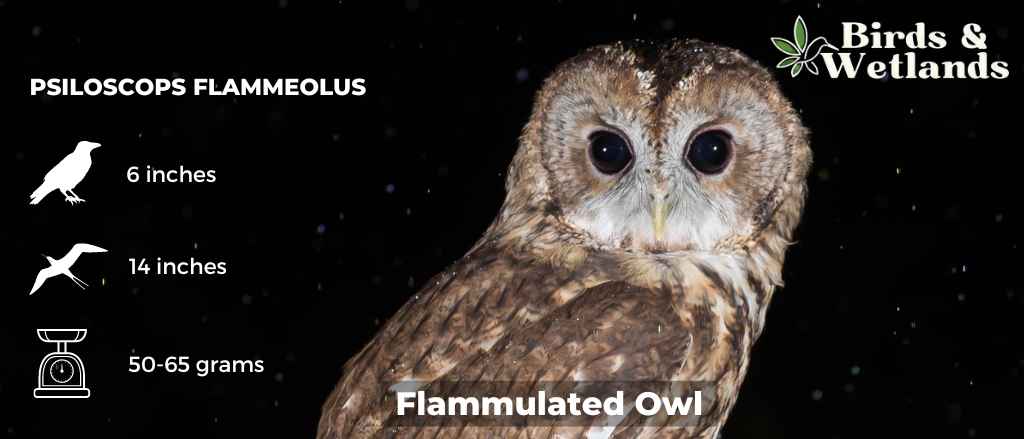
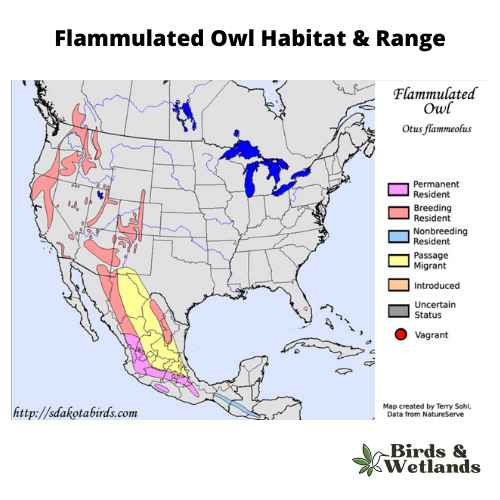
Flammulated Owl Sound
Scientific Name: Psiloscops flammeolus
Length: 6 in
Wingspan: 14 in
Weight: 1.8 – 2.3 oz
The Flammulated Owl is a small owl species native to North America, notable for its incredible migratory journeys, which may span thousands of miles.
Flammulated Owls name “flammulated” comes from the Latin word for flame, and it refers to their flame-like markings. These owls sport a mottled gray and rust color, with dark eye patches and a white throat. Their small size and cryptic plumage help them to blend into the bark of the trees in which they reside.
One of the defining traits of the Flammulated Owl is their diet they predominantly eat insects, particularly moths and beetles.
These owls prefer to nest in mature forests, often in old woodpecker holes or natural tree cavities. They typically lay 2-4 eggs, with the female incubating them for about three weeks, while the male provides food.
Flammulated Owls are known for their soft, low hooting call which can be difficult to hear. This, along with their excellent camouflage, often makes them challenging to spot, despite their widespread distribution.
Elf Owl


Elf Owl Sound
Scientific Name: Micrathene whitneyi
Length: 4.9 to 5.7 in
Wingspan: 10.5 in
Weight: 1.4 oz
The Elf Owl is a small species of owl that inhabits the southwestern regions of the United States and Mexico. It holds the distinction of being one of the smallest owl species in the world.
Elf Owls are tiny, they have a round head with no ear tufts, large yellow eyes, and a pale gray-brown body with a lightly spotted or streaked pattern.
The primary habitat for Elf Owls includes desert and woodland areas. They are especially fond of regions with saguaro cacti or other types of cavities in trees, which they use for nesting. They are nocturnal creatures, with most of their activity occurring after dusk.
Elf Owls feed primarily on a diet of insects and other small invertebrates. Occasionally, they may also eat small mammals and birds. They are known for their agile flight and keen hunting skills, often catching insects in midair.
When it comes to nesting, Elf Owls take advantage of the natural cavities in trees or cacti, where they lay a clutch of 2 to 4 eggs. The female is responsible for incubation, which lasts about three weeks, while the male provides food.
Osprey (Pandion haliaetus)

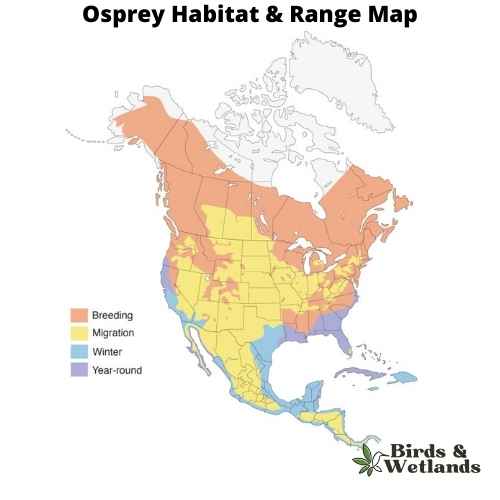
Osprey Sound
Scientific Name: Pandion haliaetus
Length: 50–66 cm (19+1⁄2–26 in)
Wingspan: 127–180 cm (50–71 in)
Weight: 0.9–2.1 kg (2 lb 0 oz – 4 lb 10 oz)
The Osprey, a fascinating bird of prey, is universally known for its exceptional hunting prowess and striking physical characteristics. Osprey are dark brown hawks on the upperparts, contrasting beautifully with the predominantly white underparts, and a distinctive dark band that stretches across the eyes towards the sides of its head.
Equipped with specialized talons and a reversible outer toe, the Osprey’s hunting strategy involves a spectacular plunge-dive into bodies of water, often emerging with a fish securely gripped in its claws.
Found on every continent except Antarctica, the Osprey is a cosmopolitan species favoring habitats near water bodies such as lakes, rivers, and coastal areas, reflecting its piscivorous diet. This bird has a diet almost exclusively of fish, making it a unique member of the raptor family and often referred to as the sea hawk or fish hawk. They locate their prey from the air, often hovering before plunging feet-first to capture a fish. When it comes to breeding, Ospreys are monogamous, often mating for life.
They construct large, bulky nests made of sticks, lined with softer materials, and prefer elevated or isolated areas such as treetops or artificial structures like utility poles. Both parents share the responsibility of incubating the eggs and rearing the chicks.
Prairie Falcon (Falco mexicanus)
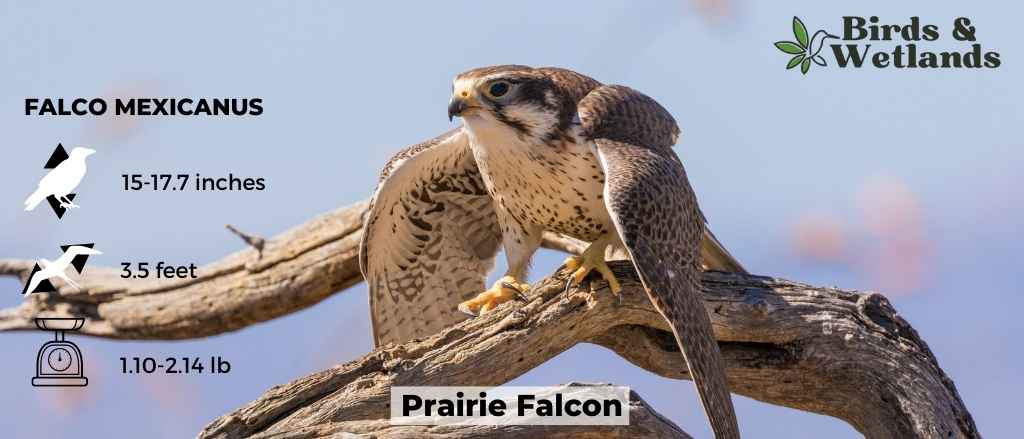
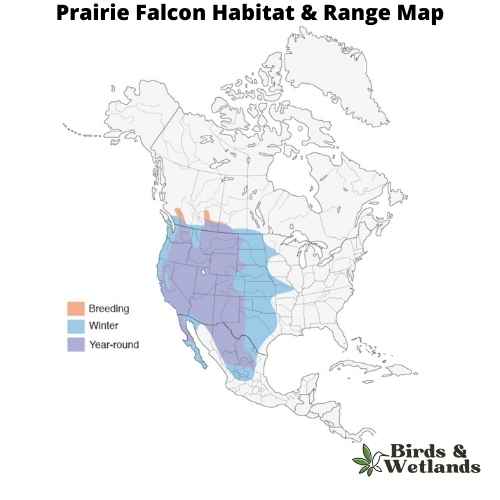
Prairie Falcon Sound
Scientific Name: Falco mexicanus
Length: 15 in – 17.7 in
Wingspan: 3.5 feet
Weight: 1.1 to 2.1 lbs
The Prairie Falcon, is a large falcon species that inhabits the open landscapes of North America, particularly in the western regions of the continent. Known for its agility and speed, this bird of prey is a skilled hunter and a master of flight.
Prairie Falcons sport a distinct color pattern with a pale, buffy brown body, contrasted with darker wingtips and a characteristic “mustache” mark near the eyes, a feature common to many falcons.
The Prairie Falcon’s diet primarily consists of small mammals and birds. It is known for its high-speed aerial pursuits, diving onto its prey from great heights. This agile predator often utilizes the open terrain of its habitat, making swift, low-level flights to catch prey off-guard.
Nesting for the Prairie Falcon often takes place on high cliff ledges, where it lays a clutch of 3 to 5 eggs. After hatching, the young falcons remain in the nest for up to six weeks, continuing to rely on their parents for food until they master hunting skills.
Where to Spot California’s Birds of Prey
Point Reyes National Seashore: Located in Marin County, this coastal area offers a variety of habitats attracting numerous raptors like Red-tailed Hawks, Northern Harriers, and White-tailed Kites. The Chimney Rock area is particularly renowned for its wintering population of Rough-legged Hawks.
Anza-Borrego Desert State Park: Situated in San Diego County, this expansive desert park is home to a diverse range of Birds of Prey. Look out for Golden Eagles, Ferruginous Hawks, Prairie Falcons, and American Kestrels soaring above the desert landscape.
Big Sur: Along the stunning Central Coast of California, Big Sur provides excellent opportunities to spot various Birds of Prey. Keep an eye out for California Condors, Peregrine Falcons, and Ospreys as they inhabit the cliffs and canyons of this rugged coastal region.
Santa Clara Valley Open Space Preserve: Located in the southern part of Santa Clara County, this preserve offers a mix of grasslands, oak woodlands, and chaparral habitats. It is a great spot to observe Swainson’s Hawks, White-tailed Kites, and Cooper’s Hawks throughout the year.
Joshua Tree National Park: In this unique desert ecosystem of southeastern California, you can find Birds of Prey such as Red-tailed Hawks, Cooper’s Hawks, and Great Horned Owls. The park’s diverse terrain, including Joshua tree forests and rocky outcrops, attracts a variety of raptor species.
California, home to an impressive array of avian predators, offers a bounty for birdwatchers. Venture into the rugged beauty of Oregon to experience the intrigue of Oregon’s Birds of Prey. Journey eastward to Nevada, where the Nevada’s Desert Raptors perfectly reflect the state’s untamed spirit. Delve into the full spectrum of these captivating creatures with our comprehensive Birds of Prey Guide.

